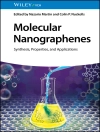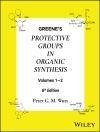Covers important name reactions relevant to heterocyclic chemistry
The field of heterocyclic chemistry has long presented a special
challenge for chemists. Because of the enormous amount and variety
of information, it is often a difficult topic to cover for
undergraduate and graduate chemistry students, even in simplified
form. Yet the chemistry of heterocyclic compounds and methods for
their synthesis form the bedrock of modern medicinal chemical and
pharmaceutical research. Thus there is a great need for high
quality, up-to-date, and authoritative books on heterocyclic
synthesis helpful to both the professional research chemist as well
as the advanced student.
Name Reactions in Heterocyclic Chemistry provides a
one-stop repository for this important field of organic chemistry.
The primary topics include three- and four-membered heterocycles,
five-membered heterocycles including indoles, furans, thiophenes,
and oxazoles, six-membered heterocycles including quinolines,
isoquinolines, and pyrimidines, and other heterocycles.
Each name reaction is summarized in seven sections:
* Description
* Historical perspective
* Mechanism
* Variations and improvements
* Synthetic utility
* Experimental
* References
Authored by a team of world-renowned contributors – some of whom
have discovered the very reactions they describe – Name
Reactions in Heterocyclic Chemistry represents a
state-of-the-art resource for students and researchers alike.
Innehållsförteckning
Foreword.
Preface.
Acronyms and abbreviations.
PART 1: THREE- AND FOUR-MEMBERED HETEROCYCLES.
Chapter 1. Epoxides and Aziridines.
1.1 Corey.Chaykovsky reaction.
1.2 Darzens glycidic ester condensation.
1.3 Hoch.Campbell aziridine synthesis.
1.4 Jacobsen.Katsuki epoxidation.
1.5 Paterno.Bchi reaction.
1.6 Sharpless-Katsuki epoxidation.
1.7 Wenker aziridine synthesis.
PART 2: FIVE-MEMBERED HETEROCYCLES.
Chapter 2. Pyrroles and Pyrrolidines.
2.1 Barton.Zard reaction.
2.2 Knorr and Paal-Knorr pyrrole syntheses.
2.3 Hofmann.L’ffler.Freytag reaction.
Chapter 3. Indoles.
3.1 Bartoli indole synthesis.
3.2 Batcho.Leimgruber indole synthesis.
3.3 Bucherer carbazole synthesis.
3.4 Fischer indole synthesis.
3.5 Gassman indole synthesis.
3.6 Graebe.Ullman carbazole synthesis.
3.7 Hegedus indole synthesis.
3.8 Madelung indole synthesis.
3.9 Nenitzescu indole synthesis.
3.10 Reissert indole synthesis.
Chapter 4. Furans.
4.1 Feist.B, nary furan synthesis.
4.2 Paal.Knorr furan synthesis.
Chapter 5. Thiophenes.
5.1 Fiesselmann thiophene synthesis.
5.2 Gewald aminothiophene synthesis.
5.3 Hinsberg synthesis of thiophene derivatives.
5.4 Paal thiophene synthesis.
Chapter 6. Oxazoles and Isoxazoles.
6.1 Claisen isoxazole synthesis.
6.2 Cornforth rearrangement.
6.3 Erlenmeyer azlactone synthesis.
6.4 Fischer oxazole synthesis.
6.5 Meyers oxazoline method.
6.6 Robinson.Gabriel synthesis.
6.7 van Leusen Oxazole Synthesis.
Chapter 7. Other Five-Membered Heterocycles.
7.1 Auwers flavone synthesis.
7.2 Bucherer.Bergs reaction.
7.3 Cook.Heilbron 5-amino-thiazole synthesis.
7.4 Hurd.Mori 1, 2, 3-thiadiazole synthesis.
7.5 Knorr pyrazole synthesis.
PART 3: SIX-MEMBERED HETEROCYCLES.
Chapter 8. Pyridines.
8.1 Preparation via condensation reactions.
8.1.1 Hantzsch (Dihydro)-pyridine synthesis.
8.1.1.1 Description.
8.1.1.2 Historical perspective.
8.1.1.3 Mechanism.
8.1.1.4 Variations.
8.1.1.4.1 Guareschi-Thorpe pyridine synthesis.
8.1.1.4.2 Chichibabin (Tschitschibabin) pyridine synthesis.
8.1.1.4.3 Bohlmann.Rahtz pyridine synthesis.
8.1.1.4.4 Kr’hnke pyridine synthesis.
8.1.1.4.5 Petrenko.Kritschenko piperidone synthesis.
8.1.1.5 Improvements or modifications.
8.1.1.6 Experimental.
8.1.1.6.1 Three-component coupling.
8.1.1.6.2 Two-component coupling.
8.1.1.7 References.
8.2 Preparation via cycloaddition reactions.
8.2.1 Boger reaction.
8.3 Preparation via rearrangement reactions.
8.3.1 Boekelheide reaction.
8.3.2 Ciamician-Dennstedt rearrangement.
8.4 Zincke reaction.
Chapter 9. Quinolines and Isoquinolines.
9.1 Bischler.Napieralski reaction.
9.2 Camps quinoline synthesis.
9.3 Combes quinoline synthesis.
9.4 Conrad.Limpach reaction.
9.5 Doebner quinoline synthesis.
9.6 Friedl’nder synthesis.
9.7 Gabriel.Colman rearrangement.
9.8 Gould.Jacobs reaction.
9.9 Knorr quinoline synthesis.
9.10 Meth.Cohn quinoline synthesis.
9.11 Pfitzinger quinoline synthesis.
9.12 Pictet.Gams isoquinoline synthesis.
9.13 Pictet.Hubert reaction.
9.14 Pictet.Spengler isoquinoline synthesis.
9.15 Pomeranz.Fritsch reaction.
9.16 Riehm quinoline synthesis.
9.17 Skraup/Doebner.von Miller reaction.
Chapter 10. Other Six.Membered Heterocycles.
10.1 Algar.Flynn.Oyamada reaction.
10.2 Beirut reaction.
10.3 Biginelli reaction.
10.4 Kostanecki.Robinson reaction.
10.5 Pinner pyrimidine synthesis.
10.6 von Richter cinnoline reaction.
Subject Index.
Om författaren
JIE JACK LI is a medicinal chemist at Pf izer Global Research and Development in Ann Arbor, Michigan. His research interests include medicinal chemistry, heterocyclic chemistry, transition metal-catalyzed reactions, and radical chemistry. He is author of Name Reactions: A Collection of Detailed Reaction Mechanisms, and coauthor of Palladium in Heterocyclic Chemistry and Contemporary Drug Synthesis, also published by Wiley.












